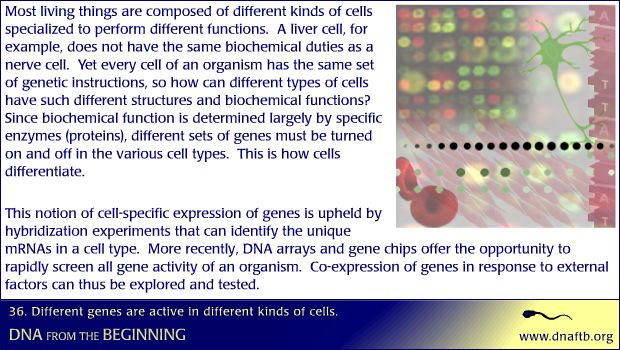Concept 36: Different genes are active in different kinds of cells.

Cells differentiate because specific enzymes turn genes on and off in various cell types.
Most living things are composed of different kinds of cells specialized to perform different functions. A liver cell, for example, does not have the same biochemical duties as a nerve cell. Yet every cell of an organism has the same set of genetic instructions, so how can different types of cells have such different structures and biochemical functions? Since biochemical function is determined largely by specific enzymes (proteins), different sets of genes must be turned on and off in the various cell types. This is how cells differentiate. This notion of cell-specific expression of genes is upheld by hybridization experiments that can identify the unique mRNAs in a cell type. More recently, DNA arrays and gene chips offer the opportunity to rapidly screen all gene activity of an organism. Co-expression of genes in response to external factors can thus be explored and tested.
dna arrays, different types of cells, gene chips, liver cell, nerve cell, hybridization experiments, genetic instructions, gene activity, enzymes, genes, organism, proteins, notion, expression
- ID: 16735
- Source: DNALC.DNAFTB
Related Content
16736. Animation 36: Different genes are active in different kinds of cells.
Igor Dawid and Thomas Sargent explain how they developed subtractive mRNA hybrization to find genes expressed by different cell types. Pat Brown and Steve Fodor show how genomes can be screened with DNA arrays and GeneChips™
15542. DNA microarray output
DNA microarrays provide the means to analyze patterns of gene expression at different timepoints in a living cell.
550. The Neural Code
Cognitive information is encoded in patterns of nervous activity and decoded by molecular listening devices at the synapse. Professor Seth Grant explains how different patterns of neural firing are critical to cognition.
1438. Gene Expression
Doctor Josh Dubnau explains that some genes are preferentially active in one part of the brain or body, while other genes are particular active in another location.
16758. Problem 36: Different genes are active in different kinds of cells.
Use DNA arrays to determine the best treatment for breast cancer.
16208. Concept 6: Genes are real things.
The study of the cell and chromosomal behavior confirmed Mendel's work.
15040. Using DNA microarrays to study cancer, Patrick Brown
Pat Brown talks about using microarrays to discover the differences between cancer cells and healthy cells.
15920. DNA arrays
In the 1990s, DNA arrays provided the means to analyze patterns of gene expression at different timepoints in a living cell.
16725. Animation 35: DNA responds to signals from outside the cell.
James Darnell explains how chemical signals turn eukaryotic genes on and off.
16113. Understanding genes and health, Stephen Fodor
Stephen Fodor talks about understanding genes and health.












